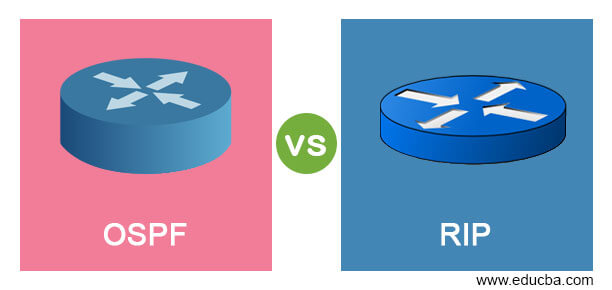Updated June 12, 2023

Difference Between OSPF vs RIP
The following article provides an outline for OSPF vs RIP. OSPF and RIP are interior gateway routing protocols which differs in many ways. Routing protocols states the rules that must be followed by the routers while interacting with other routers to learn the path and to maintain the network in routing tables. The main difference between them is OSPF is categorized into link state routing whereas RIP is categorized as vector routing protocol.
OSPF stands for Open Shortest Path First is a link state and hierarchical IGP routing protocol algorithm. OSPF enhanced the version pf RIP which comprises features likes load balancing, multipath routing, and least cost routing. Its load balancing features distribute overall traffic routes equally. To enhance the growth and ease of management OSPF divides network and routers into subsets and areas. OSPF involves type of service routing which means multiple routes can be installed according to the priority or type of service. Routing is done by sustaining the database with link state information in the routers and route the weight computed using link state and IP address. To update the database the link states are transmitted from autonomous system to routers. After that, on the basis of the information stored in the database, each routers build shortest path tree as a root node. OSPF enables the authentication mechanism, it offers two type of authentication methods namely MD5 algorithm and simple password. OSPF supports subnet specific, classless routes, classfull network specific routes and hosts.
RIP stands for Routing Information Protocol, uses vector routing protocol for local networks. After every 30 seconds it sends the routing table to all active Interfaces. To find the best route, it uses hop count. The hope count limit is 15. There are two types of RIP version RIP version 1 and RIP version 2. RIP uses four types of timers namely update timer, invalid timer and hold down timer and flush timer. Update timer specify how frequent router will send routing table update. The default value is 30. Invalid timer defines the time for the route till which it could be remain in the routing table before being considered as invalid if now new updates are aware of this route. The default value is 180 seconds. Hold down timer defines time till which route is forbidden from receiving the updates. In hold down state, RIP will not receive any new updates. Flush timer defines how long a route can be retained in routing table ahead of getting flushed out when no new updates are received m the default value is 240 seconds.
Head to Head Comparison Between OSPF vs RIP (Infographics)
Below are the top 10 differences between OSPF vs RIP:
Key Difference Between OSPF vs RIP
Let us discuss some of the major key differences between OSPF vs RIP:
- Administrative distance is used to measure the probity of received routing information on router from neighbour router. This administrative distance can vary from 0 to 255 where 0 specify the more trusted integer and 255 means no traffic is allowed to pass this route. For RIP administrative value is 120 whereas for OSPF it is 110.
- In OSPF, there is no limit of hop count whereas in RIP hop count limit is 15.
- In RIP convergence is slow in contrast, whereas in OSPF it is fast.
- OSPF depends on bandwidth which helps it to determine the best path for route whereas RIP depends on hop count to determine the best path.
- In routing summarization allow single routing gable entry to illustrate the collection of IP network numbers. OSPF supports manual summarization whereas RIP supports auto summarization.
OSPF vs RIP Comparison Table
Let’s discuss the top comparison between OSPF vs RIP:
| OSPF | RIP |
| OSPF stands for Open Shortest Path First. | RIP stands for Routing Information Protocol. |
| OSPF uses Dijkstra algorithm. | RIP uses Bellman ford algorithm. |
| It uses IP and port 89. | It uses UDP and port 20. |
| It is categorized into link state routing protocol. | It uses distance vector routing protocol. |
| Administrative distance is 110. | Administrative distance is 120. |
| Bandwidth is a default metrics. | Ho count is default metrics. |
| It is faster. | It is slower than OSPF. |
| Process take place manually. | Process is automatically updated. |
| It updates when changes occurs. | It updates after every 30 seconds. |
| Multicast address used in OSPF is 224.0.0.5 and 224.0.0.6. | Multicast address used in RIP is 224.0.0.9. |
Conclusion
The main difference between OSPF and RIP is OSPF falls under link state routing and RIP falls under distance vector routing. Here in this article we have covered the main distinguish between OSPF and RIP with the help of comparison table and key differences.
Recommended Articles
This is a guide to OSPF vs RIP. Here we discuss the OSPF vs RIP key differences with infographics and comparison table respectively. You may also have a look at the following articles to learn more –

